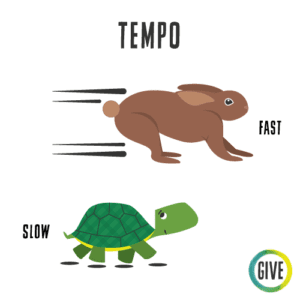কন্ডাক্টর
কর্তৃক অবদান টি স্কট লিলি
![]()
![]()
Description
In this skill building activity students work together as an ensemble, following directions, and leading the group. Students will learn and understand the terms “dynamics”, “volume”, and “tempo.”
দিকনির্দেশ
- Introduction:
- Start by having everyone sing a short familiar song together such as the Alphabet Song or Happy Birthday.
- Then share: “ Let’s add dynamics to our song.” In your own words define dynamics; the way a song or piece of music is played or sung including tempo; how fast or slow it is performed. Add in volume; how loud or soft it is. Depending on the students you can introduce further terms including crescendo, decrescendo legato and staccato.”
- Conducting Learning:
- Explain to the students that you will now conduct them in singing the song again, this time using dynamics.”
- First, practice volume: “If I raise one hand up high it means sing loud; low, sing low; in the middle, sing medium volume.” Sing the song focusing on changing the volume.
- Next practice tempo: “In my other hand I will hold my baton which I will move back and forth (MODEL) If I want you to sing fast, I’ll move it back and forth fast. If I want you to sing slowly I’ll move it back and forth slowly. (MODEL) Sing the song again, this time focusing on changing the tempo.
- Share starting and stopping: A raised hand closed into a fist to stop and open to begin. Sing the song again, this time focusing on starting and stopping.
- Practice the song combining all 3 elements together.
- Student-Led Conducting :
- Ask a Classroom Professional to be the first volunteer to model being the conductor.
- Choose a student to lead. Repeat as many times as your session permits and/or while students are still engaged.
- Variations:
- Divide the whole group into smaller groups, and conduct each one differently. For example, one group sings softly; the other loudly.
- Spread the activity over several sessions, each time adding another key term. For example, session one introduces volume and session two reviews volume and adds tempo.
কার্যকলাপে রূপান্তর
Play a piece of orchestral music and pretend to be conducting it. Reflect on what the students noticed about the music and the conducting.
কার্যকলাপের বাইরে স্থানান্তর
Be the Conductor for the final round. End the song slow and soft. Lift your hand up and close your fist and say, “The End.”
শ্রেণীকক্ষের ব্যবস্থা
Have students gather in a circle, or in an arrangement that allows the Conductor to be observed by everyone.
সমর্থন/অভিযোজিত উপকরণ/সরঞ্জাম
- This activity can be done humming, clapping, tapping, playing an instrument, or with a single word or sound (la, la,la, la). The Conductor can conduct with just a finger or eyebrows and facial expressions.
- Learn a refrain of a song from another culture and/or different language. If students share a song they are familiar with, learn it.
- কাজে লাগান visual vocabulary for key terms.
- Show videos of Victor Borges conducting for fun.
Possible Roles for Classroom Professionals
Classroom Professionals can model, lead, participate, encourage brave conductors and otherwise assist as needed.
Adjustments for Remote Instruction
![]()
Everyone is muted, but they are singing and following the Conductor.



